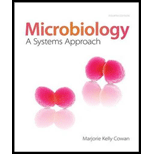
Microbiology: A Systems Approach
4th Edition
ISBN: 9780073402437
Author: Marjorie Kelly Cowan Professor
Publisher: McGraw-Hill Education
expand_more
expand_more
format_list_bulleted
Concept explainers
Question
Chapter 12, Problem 6MCQ
Summary Introduction
Introduction:
Bacteriophage integrates their genome into the bacterial cell. The horizontal gene transfer (HGT) causes the transfer of DNA from one cell to another. In this case, the phage infects the bacterial cell by integrating their genome into the bacterial genome. The phage genome then induces certain changes into the host genome that results in transformation of the host to virulent strain.
Expert Solution & Answer
Want to see the full answer?
Check out a sample textbook solution
Students have asked these similar questions
Standard Concentration (caffeine) mg/L
Absorbance Reading
10
0.322
20
0.697
40
1.535
60
2.520
80
3.100
Please draw in the missing answer, thank you
Please fill in all blank questions, Thank you
Chapter 12 Solutions
Microbiology: A Systems Approach
Ch. 12.1 - State the main goal of antimicrobial treatment.Ch. 12.1 - Identify sources of the most commonly used...Ch. 12.1 - Summarize two methods for testing antimicrobial...Ch. 12.1 - Prob. 4AYPCh. 12.2 - Prob. 5AYPCh. 12.2 - Describe the five major targets of antimicrobial...Ch. 12.2 - Identify which categories of drugs are most...Ch. 12.3 - Prob. 2CFCh. 12.3 - Prob. 8AYPCh. 12.3 - Trace the development of penicillin...
Ch. 12.3 - Prob. 10AYPCh. 12.3 - Prob. 11AYPCh. 12.3 - Prob. 12AYPCh. 12.3 - Prob. 13AYPCh. 12.3 - Identify the cellular target of quinolones, and...Ch. 12.3 - Prob. 15AYPCh. 12.3 - Prob. 16AYPCh. 12.3 - Prob. 17AYPCh. 12.3 - Prob. 18AYPCh. 12.3 - Describe two major modes of action of antiviral...Ch. 12.4 - Prob. 20AYPCh. 12.4 - Prob. 21AYPCh. 12.4 - Discuss at least three novel antimicrobial...Ch. 12.5 - Distinguish between drug toxicity and allergic...Ch. 12.5 - Prob. 24AYPCh. 12 - Prob. 1CFCh. 12 - Prob. 1MCQCh. 12 - Prob. 2MCQCh. 12 - Prob. 3MCQCh. 12 - Microbial resistance to drugs is acquired through...Ch. 12 - Prob. 5MCQCh. 12 - Prob. 6MCQCh. 12 - Prob. 7MCQCh. 12 - Which of the following modes of action would be...Ch. 12 - Prob. 9MCQCh. 12 - Prob. 10MCQCh. 12 - Prob. 11TFCh. 12 - Prob. 12TFCh. 12 - Biofilms are difficult to treat and do not always...Ch. 12 - Prob. 14TFCh. 12 - Prob. 15TFCh. 12 - Construct a paragraph describing the...Ch. 12 - Prob. 2CTQCh. 12 - Prob. 3CTQCh. 12 - Prob. 4CTQCh. 12 - Prob. 5CTQCh. 12 - Prob. 6CTQCh. 12 - Antibiotic-resistance genes, as well as other...Ch. 12 - Prob. 8CTQCh. 12 - Prob. 9CTQCh. 12 - Prob. 10CTQCh. 12 - Prob. 1CCCh. 12 - Prob. 2CCCh. 12 - Figure 12.5. Where could penicillinase affect each...Ch. 12 - From chapter 6, process figure 6.14a. Describe as...Ch. 12 - Prob. 1CM
Knowledge Booster
Learn more about
Need a deep-dive on the concept behind this application? Look no further. Learn more about this topic, biology and related others by exploring similar questions and additional content below.Similar questions
- please fill in missing parts , thank youarrow_forwardplease draw in the answers, thank youarrow_forwarda. On this first grid, assume that the DNA and RNA templates are read left to right. DNA DNA mRNA codon tRNA anticodon polypeptide _strand strand C с A T G A U G C A TRP b. Now do this AGAIN assuming that the DNA and RNA templates are read right to left. DNA DNA strand strand C mRNA codon tRNA anticodon polypeptide 0 A T G A U G с A TRParrow_forward
- Please identify the curve shown below. What does this curve represent? Please identify A, B, C, D, and E (the orange oval). What is occurring in these regions?arrow_forwardPlease identify the test shown here. 1) What is the test? 2) What does the test indicate? How is it performed? What is CX? 3) Why might the test be performed in a clinical setting? GEN CZ CX CPZ PTZ CACarrow_forwardDetermine how much ATP would a cell produce when using fermentation of a 50 mM glucose solution?arrow_forward
- Determine how much ATP would a cell produce when using aerobic respiration of a 7 mM glucose solution?arrow_forwardDetermine how much ATP would a cell produce when using aerobic respiration to degrade one small protein molecule into 12 molecules of malic acid, how many ATP would that cell make? Malic acid is an intermediate in the Krebs cycle. Assume there is no other carbon source and no acetyl-CoA.arrow_forwardIdentify each of the major endocrine glandsarrow_forward
arrow_back_ios
SEE MORE QUESTIONS
arrow_forward_ios
Recommended textbooks for you
- Surgical Tech For Surgical Tech Pos CareHealth & NutritionISBN:9781337648868Author:AssociationPublisher:Cengage

 Biology Today and Tomorrow without Physiology (Mi...BiologyISBN:9781305117396Author:Cecie Starr, Christine Evers, Lisa StarrPublisher:Cengage Learning
Biology Today and Tomorrow without Physiology (Mi...BiologyISBN:9781305117396Author:Cecie Starr, Christine Evers, Lisa StarrPublisher:Cengage Learning  Comprehensive Medical Assisting: Administrative a...NursingISBN:9781305964792Author:Wilburta Q. Lindh, Carol D. Tamparo, Barbara M. Dahl, Julie Morris, Cindy CorreaPublisher:Cengage Learning
Comprehensive Medical Assisting: Administrative a...NursingISBN:9781305964792Author:Wilburta Q. Lindh, Carol D. Tamparo, Barbara M. Dahl, Julie Morris, Cindy CorreaPublisher:Cengage Learning Concepts of BiologyBiologyISBN:9781938168116Author:Samantha Fowler, Rebecca Roush, James WisePublisher:OpenStax College
Concepts of BiologyBiologyISBN:9781938168116Author:Samantha Fowler, Rebecca Roush, James WisePublisher:OpenStax College

Surgical Tech For Surgical Tech Pos Care
Health & Nutrition
ISBN:9781337648868
Author:Association
Publisher:Cengage


Biology Today and Tomorrow without Physiology (Mi...
Biology
ISBN:9781305117396
Author:Cecie Starr, Christine Evers, Lisa Starr
Publisher:Cengage Learning

Comprehensive Medical Assisting: Administrative a...
Nursing
ISBN:9781305964792
Author:Wilburta Q. Lindh, Carol D. Tamparo, Barbara M. Dahl, Julie Morris, Cindy Correa
Publisher:Cengage Learning


Concepts of Biology
Biology
ISBN:9781938168116
Author:Samantha Fowler, Rebecca Roush, James Wise
Publisher:OpenStax College